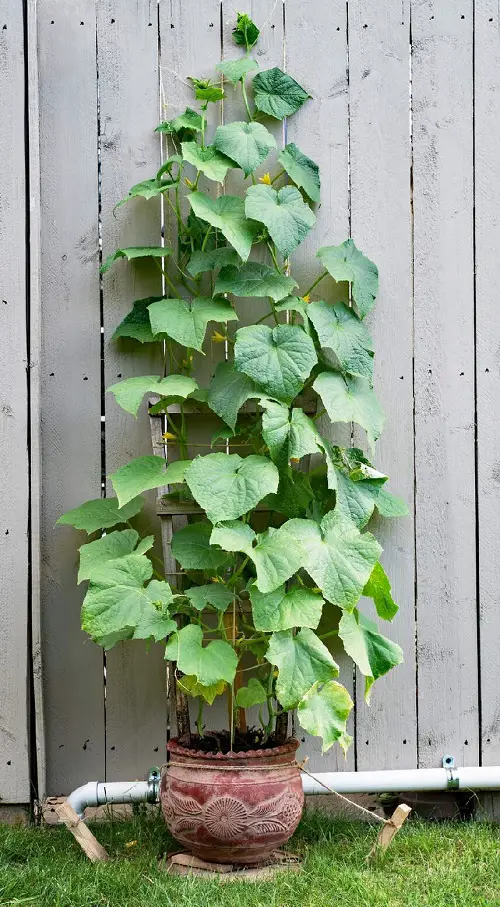Cucumbers taste better much better when they are home-grown. Here’s everything on Growing Cucumbers in Pots in a small space.
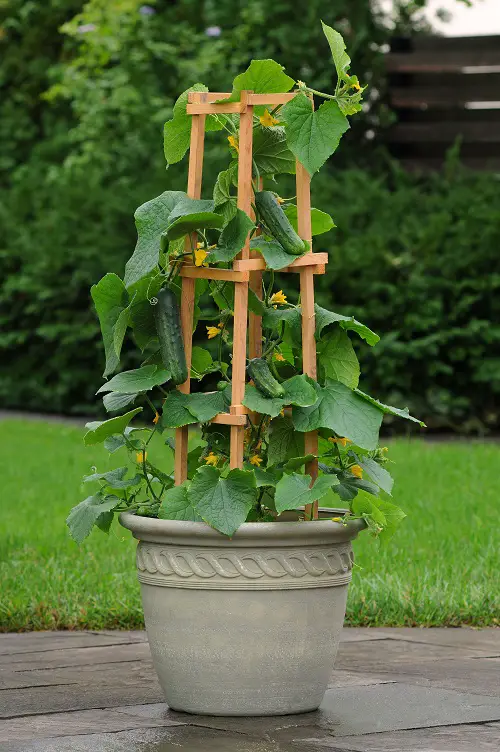
Cucumbers grow on long vines, but don’t let that stop you from growing them fresh on your balcony if you live in an apartment or patio if you don’t have a garden. Let’s have a look at all the information on Growing Cucumbers in Pots.
Here is Everything About Growing Cucumbers On Trellis
Best Container Size for Growing Cucumbers
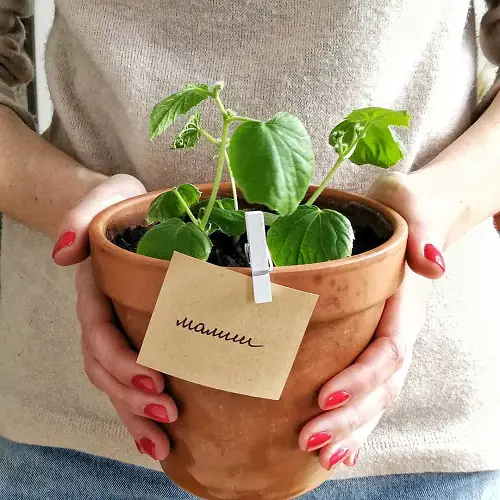
As cucumbers have an extensive root system to support the long vines, you will need a 12-14-inch pot. Since bigger planters can hold more potting soil, this is the best way to make sure the soil holds water for a longer time.
The fruits depend on a consistent moisture level, and if the container is too small, it will dry out very fast. Also, a large container will give the plant a proper footing, too.
Best Cucumber Varieties to Grow in Pots
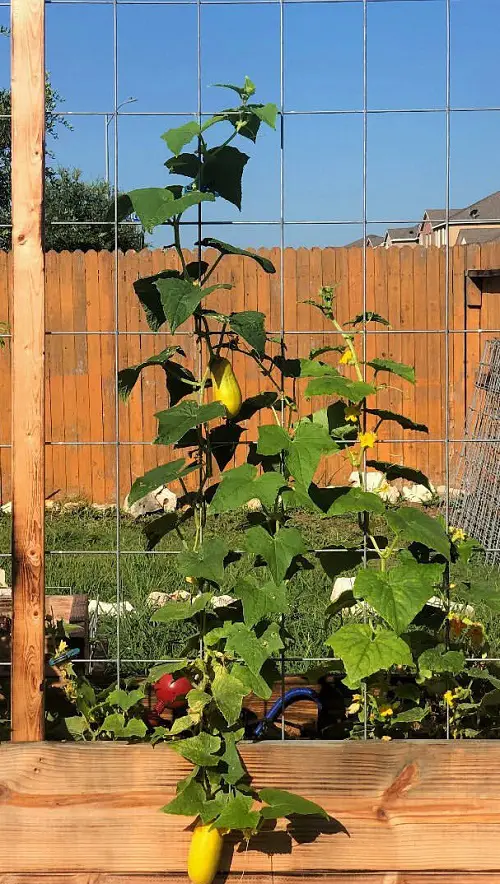
- Paraiso F1: A high-yielding variety. Gets ready in 55-60 days.
- Poona Kheera: A popular variety from India with a juicy, crisp texture. Gets ready in 50-60 days.
- H-19 Little Leaf: Self-pollinating variety. Gets ready in 60-65 days.
- National Pickling: As the name suggests, it is best for pickling. Gets ready in 60-65 days.
- Picolino F1: Has thin skin and mild flavor. Gets ready in 45-50 days.
Here are the best cucumbers you can grow for pickles
Propagating Cucumbers in Pots
- Choose a pot that is at least 8-12 inches deep and has good drainage.
- Fill the pot with a soil-less potting mix.
- Plant cucumber seeds 1/2 inch deep in the soil.
- Water lightly and keep the soil moist.
- Place the pot in an area with full sun and warm temperatures.
- When the seedlings emerge, thin them to leave only the strongest seedling in the pot.
- Water regularly, making sure to keep the soil moist but not soggy.
Learn How to Grow Cucumbers in Unique Shapes
Requirements for Growing Cucumbers in Pots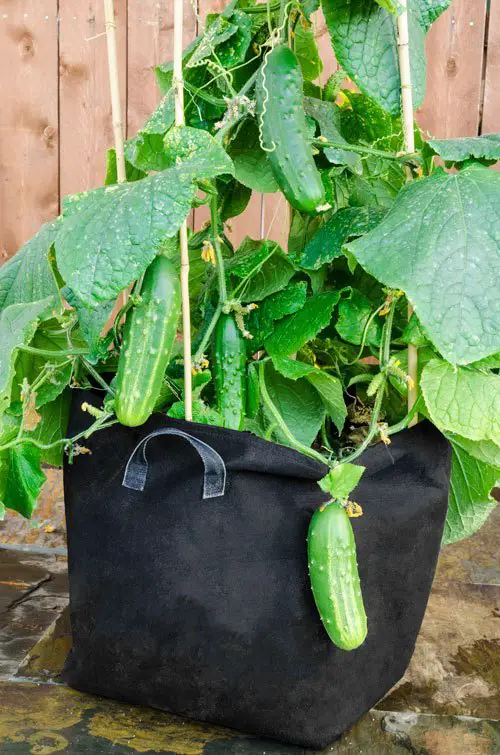
Sunlight
Cucumbers require full sun or at least 5-6 hours of direct sunlight per day in order to thrive. They should be grown in a sunny spot, with plenty of space between plants.
Make sure not to plant them in an area that remains shaded for the most part of the day.
Soil
These plants require soil that is well-draining, rich in organic matter, and has a pH between 6.0 and 7.0. The growing medium should be amended with compost and/or aged manure to increase the nutrient content.
Also, the soil should be rich in organic matter such as compost, aged manure, or peat moss.
Water
Cucumbers require a lot of water to grow and thrive. They should be watered regularly and deeply to ensure that their roots are able to absorb enough moisture.
During the warmer months, cucumbers will need to be watered daily or even twice a day in some cases. When the weather is cooler, the frequency of watering can be reduced.
It’s important to check the soil regularly to make sure that it is not overly dry, as this can cause the cucumbers to be stunted in their growth.
Temperature
The ideal temperature range for growing cucumbers is between 65°F and 85°F (18°C and 29°C).
Taking Care of Cucumbers in Pots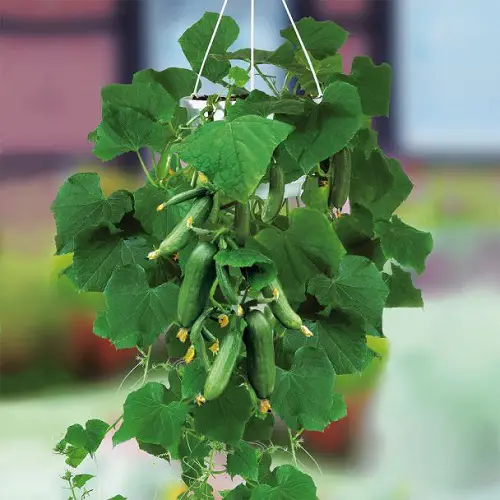
Fertlizer
The fertilizers for cucumbers must be high in nitrogen and contain a balanced mix of macronutrients, including phosphorus and potassium.
A 10-10-10 fertilizer is best, although an 8-24-24 fertilizer can also be used. Organic fertilizers such as compost, manure, or seaweed extracts are also a great choice.
Additionally, a monthly supplement of micronutrients such as calcium, magnesium, and boron may be necessary for the best results. Make sure to read the instruction manual for the dosage and instructions.
Here are Powerful DIY Cucumber Fertilizers You Should Try Once!
Support
Trellises are an excellent way to support the growth of cucumbers. They provide a vertical structure for the vines to climb up and produce more fruit.
The trellis should be tall enough to accommodate the growth of the cucumber vines and provide enough space between the individual strings or nets to allow the cucumbers to hang freely and grow without restriction.
In addition, it is important to provide adequate support for the trellis as cucumbers are heavy and can cause the structure to become unstable.
Pests and Diseases
1. Downy Mildew: This fungal disease causes yellowing and wilting of leaves and can spread quickly throughout the cucumber plants.
2. Powdery Mildew: This fungal disease causes white, powdery spots on leaves and can spread quickly throughout the cucumber plants.
3. Cucumber Beetle: These small beetles feed on the leaves, flowers, and fruit of cucumber plants, causing damage and transmitting bacterial wilt disease.
4. Aphids: These small, soft-bodied insects can cause distorted leaves and stunted plant growth.
5. Fusarium Wilt: This fungal disease causes yellowing and wilting of leaves and can spread quickly throughout the cucumber plants.
6. Bacterial Wilt: This disease is caused by a bacterium and can cause wilting and death of the cucumber plants.
7. Blossom End Rot: This is caused by a calcium deficiency and is characterized by a brown, leathery patch at the blossom end of the cucumber.
To keep the pests and diseases in check, use the following precautions:
1. Use disease-resistant varieties: Plant varieties of cucumbers that are resistant to common diseases, such as powdery mildew or downy mildew.
2. Remove infected plants: If you notice any plants with signs of pests or disease, remove them from the garden immediately.
3. Keep the plants clean: Remove any dead or decaying plants and debris from the garden to reduce the chances of pests and diseases.
4. Use insecticides or fungicides: If pests or diseases are still present, use an appropriate pesticide or fungicide to control them. Be sure to follow the instructions on the label.
5. Water in the morning: Water your cucumbers in the morning to allow the leaves to dry before nightfall and reduce the chance of fungal diseases.
Here are the best tips on avoiding bitter-tasting cucumbers
Harvesting and Storing Cucumbers
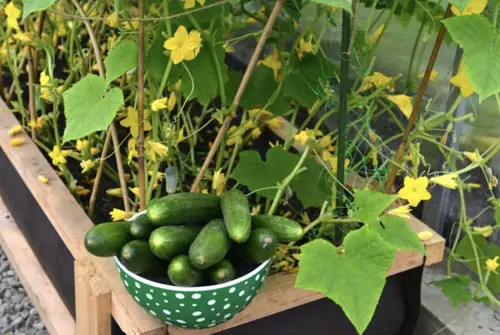
Harvesting
Cucumbers should be harvested when they are firm and dark green. The skin should be glossy, and the cucumber should be the appropriate size for the variety. When harvesting, use a sharp knife or scissors to avoid damage to the plant.
Storing:
Cucumbers should be stored in a cool, dark, and dry place. They should be wrapped in a paper towel and, stored in a plastic bag, placed in the refrigerator. Cucumbers should be used within a week of harvesting.


